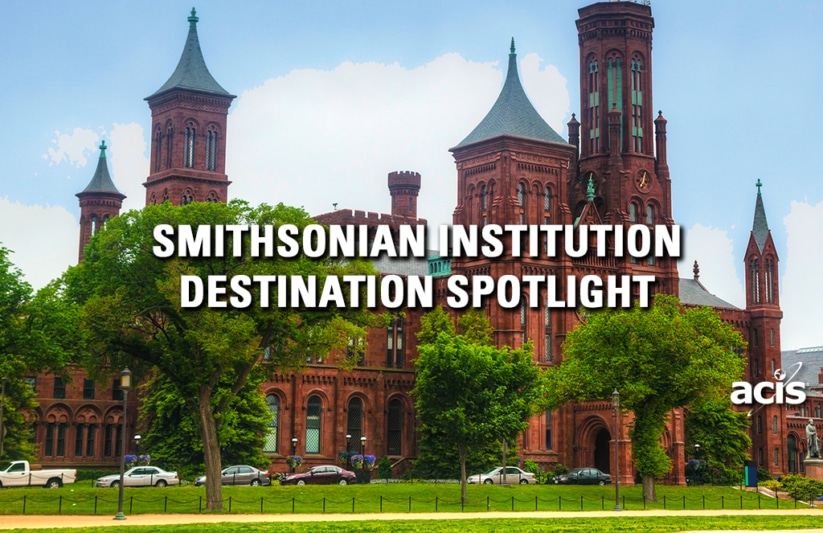The Smithsonian Institution – Destination Spotlight

Few places in America encapsulate as much history and education as the Smithsonian Institution in Washington, D.C. Established in 1846, the Smithsonian is a group of museums managed by the US Government. With over twenty-five million visitors annually, the Smithsonian has not only attracted people through its historical and scientific offerings but has become a national landmark in and of itself.
What might be just as fascinating as the millions of historical artifacts it contains is the Smithsonian’s own origins and how it came to be what it is today. In 1829, a British scientist by the name of James Smithson passed away and left most of his wealth to his nephew. When his nephew died in 1835 with no apparent heir to that heritance, the estate left it, “to the United States of America, to found at Washington, under the name of the Smithsonian Institution, an Establishment for the increase and diffusion of knowledge among men.”
After Congress accepted the will in 1836, then president Andrew Jackson sent American diplomat Richard Rush to collect the inheritance. Rush returned in August of 1838 with 105 sacks containing 104,960 gold sovereigns, which at the time was worth about $500,000 (today that would equate to over $11.1 million). For the next eight years, Congress debated the interpretation of the will and how they should meet Smithson’s final request. It was John Quincy Adams who finally convinced them to build an institution of science and learning. On August 10, 1846, President James K. Polk signed the legislation that created what would become the Smithsonian Institution.
In the beginning, it was not abundantly clear what would go in the Smithsonian. Today, it seems like it holds anything and everything. Between 1838 and 1842, the United States Exploring Expedition by the US Navy traveled the globe. They brought back a variety of treasures including plant and animal specimens, tropical birds, diverse shells and minerals and even jars of seawater. Other items were gathered from the western part of the country that contributed to the Native American and natural history collections.
Today, the Smithsonian Institution is comprised of nineteen museums and galleries, nine research centers as well as the National Zoologist Park. Eleven of the nineteen museums are located on the National Mall, which is the park that stretches between the Lincoln Memorial and the United States Capitol. Other museums that are part of the Institution are located elsewhere in D.C. with two more in New York City and one in Chantilly, Virginia. The Smithsonian has close affiliations with 168 other museums across thirty-nine states, Panama and Puerto Rico. The most well-known museums are The National Air and Space Museum, The National Museum of Natural History, The National Portrait Gallery and The National Museum of American History.
The Smithsonian is home to over 156 million artifacts, artworks, and specimens. The National Museum of Natural History alone holds 145 million of these specimens and artifacts. There certainly is not a shortage of historically significant and scientifically important items to uncover. Some of the more interestingly historic items include the stove pipe hat that was worn by Abraham Lincoln, the ruby slippers worn by Judy Garland in The Wizard of Oz and the original teddy bear that was named after President Theodore Roosevelt. A new edition this year, which curators were able to restore, is the original USS Enterprise from the Star Trek TV series.
The historical significance of the Smithsonian has translated into popular culture and has made it an American icon. From movies to books to television, the museums have been a standout amongst the many D.C. landmarks. Shortly after its founding, the Smithsonian appeared in Mark Twain’s 1869 novel The Innocents Abroad where he coined the nickname, “The Nation’s Attic”. It first started appearing on the big screen in sci-fi movies in the 1950s where the buildings were backdrops for alien invasions. The Smithsonian can be seen in famed films such as The Silence of the Lambs, Star Trek and Night at the Museum: Battle of the Smithsonian.
Any educational journey to our nation’s capital could not be complete without a stop at the Smithsonian. Take in all the incredible educational content America has to offer in one place. With so many exciting and informative exhibits, the Smithsonian Institution thoroughly opens up the past, present, and future.
Have you been to the Smithsonian? What’s your favorite museum? Let us know in the comments section below!
TOP 10 EDUCATIONAL TRAVEL EXPERIENCES IN THE USA
Free Travel Guide
Learn about 10 Fantastic Places in The US to Go with Your Students!











I love being able to visit DC …within an hour or so, I can take in a museum. My favorites are the National Gallery for their amazing Impressionist artwork and the American History Museum to see Julia Child’s kitchen!! 🙂